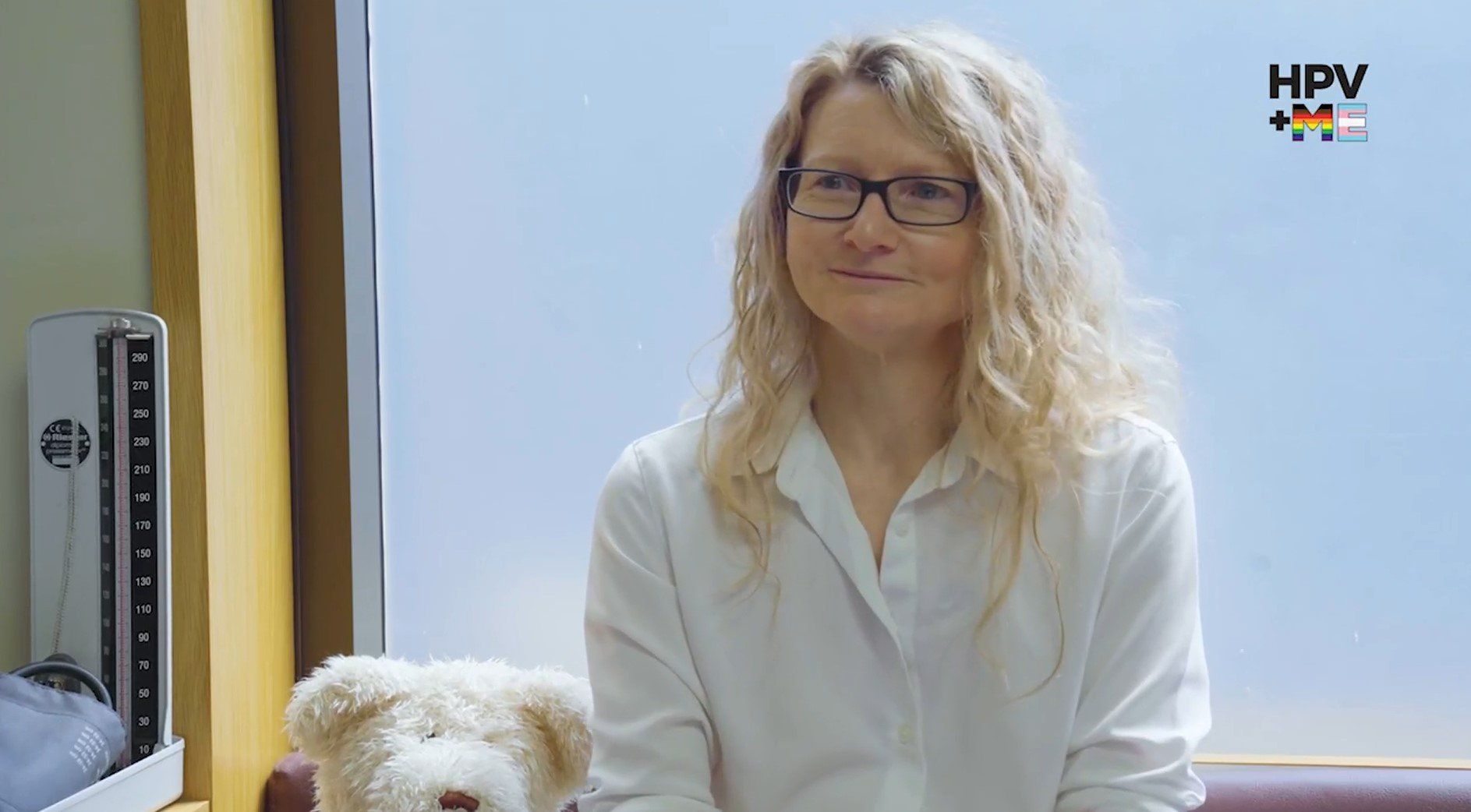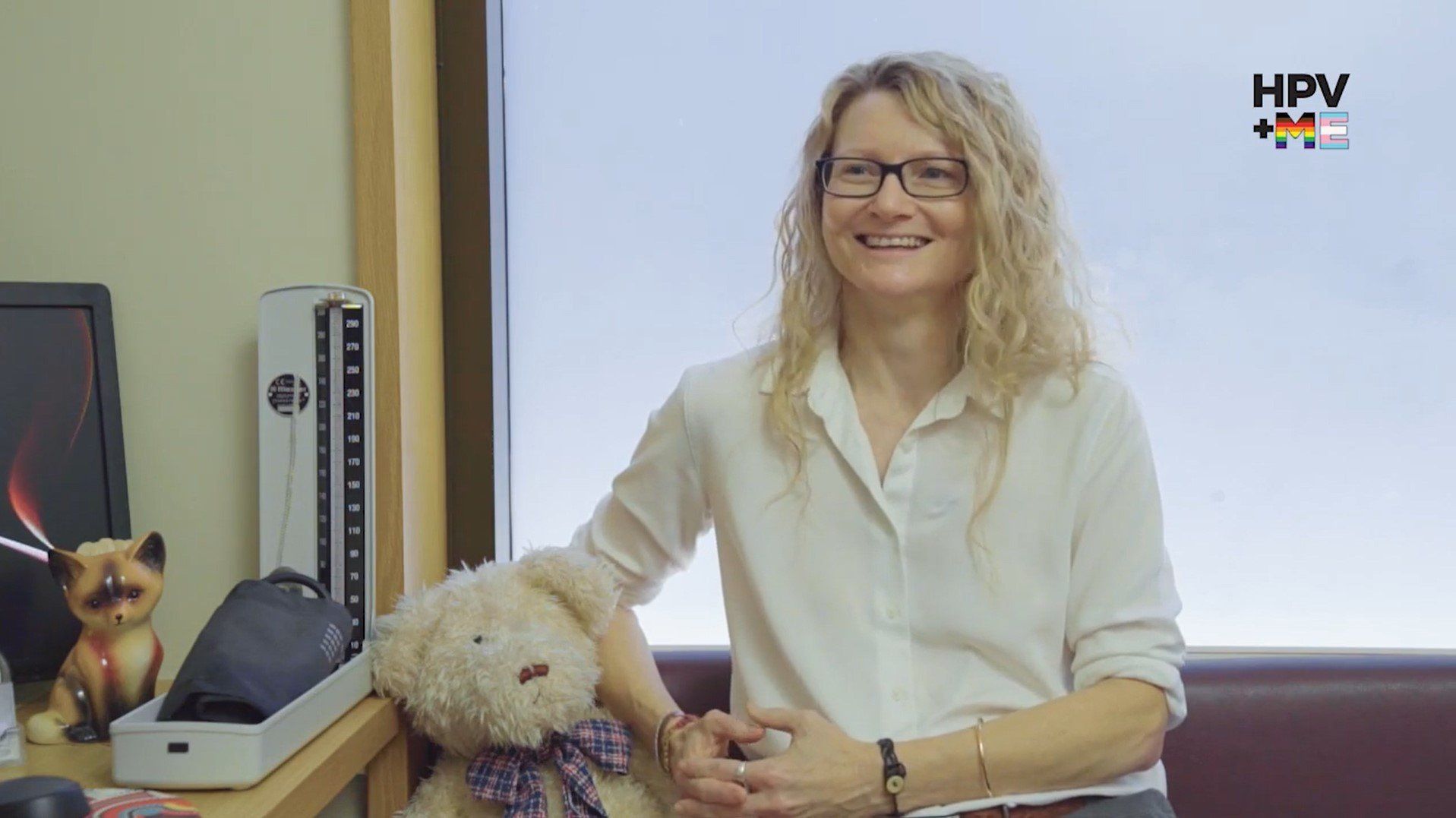For Practitioners
Hi, I’m Dr Fiona Bisshop, a Brisbane-based General Practitioner.
Click on the underlined words to learn their definition.
My special interests include trans health (I’m the current President of the Australian Professional Association for Trans Health and run workshops on gender affirming medical care), HIV and PrEP (I’m on the ASHM guidelines committee for HIV treatments), and sexual health. I’ve also written the Doc Q column for Q News since 2009.
Today I’m discussing human papillomavirus (HPV) and LGBTIQ+ people, as the reality is, anyone in the Lesbian, Gay, Bisexual, Transgender , Intersex , Queer , Asexual , Pansexual and Sistergirl or Brotherboy communities can be exposed to HPV and need HPV related healthcare. Anyone, having any kind of sex with other people, regardless of bodies, genders or sexualities, can have and transmit HPV.
Due to prevailing myths and misinformation about HPV, along with barriers to accessing HPV related health care, LGBTIQ+ people are less likely to be aware of HPV and are less likely to access available preventative health measures.
Healthcare professionals need to be aware of the unique health needs and specific challenges that LGBTIQ+ people face in seeking HPV related health care.
Furthermore, while collectively LGBTIQ+ people have unique health needs in relation to HPV, these health needs aren’t all the same across this diverse community.
Cisgender lesbian, gay and bisexual women; transgender men;
non-binary people; transgender women; cisgender gay men; and people with intersex variations will all have different health needs related to HPV.
I’ve gathered and debunked some common myths below to assist you in your practice with the LGBTIQ+ communities.
“It's not important for me to know if my patient is LGBTIQ+. If it was relevant to their care they would just tell me.”
LGBTIQ+ people have a range of unique and specific health care needs. In some situations, GPs not knowing the sexuality, gender identity or intersex status of their patient can lead to reduced quality of care, while knowing the gender or sexual identities of patients has been associated with more positive relationships with healthcare providers[i].
Due to systemic and prevailing experiences of stigma and discrimination in healthcare settings, including microaggressions and minor incidents, LGBTIQ+ people are often hesitant to disclose information about their gender or sexuality for fear of encountering discrimination and receiving a reduced quality of care. While 83.5% of LGBTIQ+ people accessed a general medical clinic in the last 12 months, only 58% felt that their sexuality and 38% felt that their gender identity was very or extremely respected during their care[ii].
Many LGBTIQ+ people will go to great lengths to conceal their identities. Disclosing LGBTIQ+ status to a GP can be a stressful and risky experience. Only 69% of LGBTIQ+ people who have a regular GP have disclosed their sexuality[iii].
Rather than placing the responsibility on your patient to disclose this information, as a GP you can provide opportunities for patients to share. Some examples include:
- Do not assume someone is straight or cisgender based on their appearance, mannerisms, speech or dress.
- Use gender neutral pronouns when enquiring about your patients’ relationships and sexual partners.
- Ask if your patient identifies with the LGBTIQ+ communities, and if so what is their specific connection.
- Ask clearly and directly if your patient is engaging in same sex sexual behaviours.
- Do not assume a person's biological health needs on the basis of their gender or gender presentation.
- Add LGBTIQ+ affirming posters and health promotion material in your clinic waiting rooms. These are gentle indicators to the LGBTIQ+ communities that we are welcome in your space.
- Change your intake forms for new patients to allow space for them to disclose sexuality and pronouns, and offer gender options other than simply male and female.
“Only women need to be offered cervical screening. I can tell who should be offered cervical screening based on their gender or physical appearance.”
All people who have a cervix require cervical screening regardless of their gender. Do not assume someone’s biological sex characteristics on the basis of their gender.
Many people, including transgender men and people with an intersex variation may have a cervix and therefore require cervical screening.
Due to their gender and gender presentation, transgender men and intersex men are often not offered cervical screening. While some may not have a cervix (due to their natural bodily variation or as a result of a radical hysterectomy), it is important not to assume what biological sex organs a person has based on their gender or gender presentation.
Additionally, having a cervix does not denote someone's gender.
Whether your patient has a cervix or not, you should still respect that person's gender, and use their chosen name and pronouns.
“Women who have not had sex with men do not need cervical screening.”
HPV is transmitted by skin to skin contact, and can be transferred from person to person through a range of sexual behaviour.
Transmission of HPV is not reliant on the sex or gender of either sexual partner.
Anyone, having any kind of sex with other people, regardless of bodies, genders or sexualities, can have and transmit HPV.
The Cervical Screening Test is recommended for anyone over 25yrs with a cervix regardless of their sexual history. Same-sex attracted women, or women who have never had sex with cisgender men, still need cervical screening[iv].
“HPV awareness isn’t relevant for gay men.”
Regardless of gender, HPV can lead to genital or anal warts, and is the leading cause of genital, anal, mouth and throat cancers.
The incidence of anal cancer in men who have sex with men is more than 30 times higher than other men, and 100 times higher for people living with HIV[v]. Indeed the Australian Department of Health identifies men who have sex with men as a population who should be receiving the HPV vaccine [vi].
While there is no HPV testing available for people without a cervix, regular sexual health examinations, including a digital ano-rectal exam (DARE), and being aware of what signs and symptoms to look out for, can identify the presence of HPV related warts and cancers in patients.
“I know the gender of all my patients and therefore know what healthcare protocols to follow in providing them care.”
A person’s sex or gender listed on their medical file or their gender presentation does not always indicate what their biological make-up will be, nor align with the expected corresponding anatomy, genitals or reproductive organs.
An assumption that all men and male appearing people don’t require a cervical screening can result in you missing providing vital preventative health care.
Transgender men who have not had a radical hysterectomy should continue to have cervical screening in accordance to standard guidelines[vii].
People with an intersex variation, regardless of their gender or gender presentation, may have a cervix and require cervical screens[viii].
While cervical screening is not applicable to transgender women as they do not have a cervix, the skin tissue used to craft
neovaginas
is highly susceptible to HPV infection and HPV related conditions. Consequently, transwomen who have had vaginoplasty and have been sexually active require examination of their genital tissue to ensure HPV related warts or cancers have not developed within the vagina[ix].
“Having a cervical screen is a simple, stress-free, painless procedure.”
For many people having a cervical screen performed on them is a highly stressful and uncomfortable procedure, and consequently is one that is actively avoided.
For LGBTIQ+ people there may be additional discomforts that cause them to avoid cervical screening, in fact only 39% of transgender men reported having a cervical screening in the last two years[x] which is significantly lower than the 54%-56% of the general population[xi]
For people who experience body dysphoria, talking about and having someone look at and touch parts of your body that does not affirm their identity, can be extremely distressing. Cervical screening is traditionally considered a ‘women’s’ health test, so for transgender men, intersex men, and non-binary people having their bodies described using female anatomical terminology and having this test performed may feel embarrassing or dehumanising.
Additionally, many cervix owners (regardless of their gender) do not enjoy penetrative sex, this can also make cervical screens incredibly uncomfortable and painful. It’s important to not assume that all people with a cervix are comfortable with penetration.
Any person will tell you that having a speculum inserted into your body can feel invasive, uncomfortable and painful but there are many things you can do as a healthcare provider to make a cervical screen less stressful:
- Ask what the patient needs from you to feel more relaxed with the procedure
- Ask what type of language the person would like to use to describe their bodies (including genitals)
- Describe the procedure before and talk through the elements as you are doing them
- Ask permission before touching any part of their body, including legs
- Allow the patient to select the speculum size that they wish you to use
- Allow them to have a support person present
- Allow the patient to insert the speculum themselves or have their partner or support person do it for them
- Check in with them throughout the procedure and adjust as necessary
- Offer self-collected screening to those who are eligible (see below)
“Self screening is ineffective and won’t provide conclusive results.”
Many LGBTIQ+ people have actively avoided a cervical screen for many years and will continue to do so regardless of the health risks of not being tested. Self-screening is designed to capture those who aren’t going to engage in traditional testing strategies.
The self-collection cervical screening test is a swab a patient can do themselves, minimising stress and discomfort, and while a self-screen may not yield perfect results, being able to receive some results from this test is better than none at all. Offering a self-screening test can also be a great stepping stone to creating greater comfort in accessing a cervical screening test performed in-clinic. To further minimise stress, the swab can be taken home and returned later if the patient prefers.
To receive access to the cervical self-screening test patients must meet the criteria of being >30 years old and be 2 years overdue for screening.
To access self-screening pathology, companies provide a dry swab and accompanying instruction sheet for the patient on how to conduct the self-screening (you can request these from the labs). Write HPV test (self-collection) on the form and describe their eligibility.
“The HPV vaccine is only effective when provided before someone is having sex and potentially exposed to HPV.”
While the HPV vaccine is considered most effective when given before someone has been exposed to HPV, and vaccination for adults aged 19 or older is not generally recommended[xii], anyone over 9 years old who wants to protect themselves against HPV can talk to their doctor about getting immunised[xiii].
The HPV vaccine is recommended for everyone aged 12 to 13 years regardless of their sex or gender[xiv], and the decision for vaccination of adults aged 19+ years depends on the likelihood of someone having already been infected with HPV, and whether they are likely to be infected in the future [xv].
However, men who have sex with men and people who are immunocompromised who have not been previously immunised are recommended to have the HPV vaccine at any age[xvi].
These recommendations are guidelines, and anyone regardless of age may have the HPV vaccine if they wish to protect themselves against future contact with HPV. Even if someone has already had HPV, the HPV vaccine may protect them against other common strands of HPV that can cause warts and cancers that they may not yet have been exposed to[xvii].
“Diagnosing someone with HPV isn’t something to be concerned about as it is relatively common.”
Receiving an HPV diagnosis may be distressing to some people as they may not know when or how they contracted it or how long they have had HPV.
Receiving an HPV diagnosis means that a colposcopy may be required, along with more frequent cervical screen testing. This requires engaging in more frequent medical procedures that someone may find stressful and distressing, and would prefer to avoid.
It’s important to fully explain what follow up testing and future monitoring may be required after a positive HPV test, and reassure them that although HPV is common, follow-up tests will be conducted with as much care as possible.
Campaign Videos for Practitioners
If you are a health and/or medical professional, LGBTIQ+ patients have unique healthcare needs especially around HPV. Brisbane GP Dr Fiona Bisshop has been working in LGBT health and HIV medicine since 2001, and has an active interest in research. She is an S100 prescriber, and offers holistic HIV management, PrEP and advice on all sexual health matters.
As a healthcare provider, creating safety for LGBTIQ+ people to discuss their sexual health starts with you.
Having a practice and style that is welcoming to LGBTIQ+ people helps pave the way for you to offer appropriate HPV screening to all of your patients, regardless of sex, gender or sexual orientation, and opens the door to constructive discussion around sexual health in the future.
References
[i] McNair, R., Szalacha, L. & Hughes, T. (2011) Health Status, health service use and satisfaction according to sexual identity of young Australian women, Women Health Issues, 21, 40-47. Doi: 10.1016/j.whi.2010.08.002
[ii] Hill, A., Bourne, A., McNair, R., Carman, M. & Lyons, A. (2020) Private Lives 3: The health and wellbeing of LGBTIQ+ people in Australia, Australian Research Centre in Sex, Health and Society, La Trobe University, Melbourne
[iii] Leonard, W., Pitts, M., Mitchell, A., Lyons, A., Smith, A., Patel, S., Couch, M. & Barrett, A. (2012) Private Lives 2: The Second National Survey of the health and wellbeing of gay, lesbian, bisexual and transgender (GLBT) Australians, Melbourne, The Australian Research Centre in Sex, Health & Society, La Trobe University. Pg 42
[iv] Department of Health (2020) Who Should get a Cervical Screening Test Date Accessed 25/3/21 URL: https://www.health.gov.au/initiatives-and-programs/national-cervical-screening-program/getting-a-cervical-screening-test/who-should-get-a-cervical-screening-test
[v] Australasian Society for HIV, Viral Hepatitis and Sexual Health Medicine (2020) Anal Cancer in Men Living with HIV, URL: https://www.ashm.org.au/HIV/hiv-management/anal-cancer/
[vi] National Centre for Immunisation Research & Surveillance (2018) Human Papillomavirus (HPV) vaccines for Australians Fact Sheet. URL https://www.ncirs.org.au/ncirs-fact-sheets-faqs/human-papillomavirus-vaccine-australians
[vii] Ivory, K. ( ) LGBTQIA gynaecological screening, O&G Magazine, vol 20, no 4 URL: https://www.ogmagazine.org.au/20/4-20/lgbtqia-gynaecological-screening/
[viii] https://www.ogmagazine.org.au/20/4-20/lgbtqia-gynaecological-screening/
[ix] Cornelisse, V. J., Jones, R. A., Fairley, C. K., & Grover, S. R. (2017). The medical care of the neovagina of transgender women: A review. Sexual Health (Online), 14(5), 442-450. doi:http://dx.doi.org.libraryproxy.griffith.edu.au/10.1071/SH17044
[x] Leonard, W., Pitts, M., Mitchell, A., Lyons, A., Smith, A., Patel, S., Couch, M. & Barrett, A. (2012) Private Lives 2: The Second National Survey of the health and wellbeing of gay, lesbian, bisexual and transgender (GLBT) Australians, Melbourne, The Australian Research Centre in Sex, Health & Society, La Trobe University.
[xi] Australian Institute of Health and Welfare (2019) Cervical Screening in Australia 2019, Australian Institute of Health and Welfare, Canberra
[xii] National Centre for Immunisation Research & Surveillance (2018) Human Papillomavirus (HPV) vaccines for Australians Fact Sheet. URL
https://www.ncirs.org.au/ncirs-fact-sheets-faqs/human-papillomavirus-vaccine-australians
[xiii] Department of Health (2020) Human Papillomavirus (HPV) Immunisation Service, Australian Government. URL: https://www.health.gov.au/health-topics/immunisation/immunisation-services/human-papillomavirus-hpv-immunisation-service
[xiv] National Centre for Immunisation Research & Surveillance (2018) Human Papillomavirus (HPV) vaccines for Australians Fact Sheet. URL https://www.ncirs.org.au/ncirs-fact-sheets-faqs/human-papillomavirus-vaccine-australians
[xv] Department of Health (2020) Human Papillomavirus (HPV) Immunisation Service, Australian Government. URL: https://www.health.gov.au/health-topics/immunisation/immunisation-services/human-papillomavirus-hpv-immunisation-service
[xvi] National Centre for Immunisation Research & Surveillance (2018) Human Papillomavirus (HPV) vaccines for Australians Fact Sheet. URL https://www.ncirs.org.au/ncirs-fact-sheets-faqs/human-papillomavirus-vaccine-australians
[xvii] Department of Health (2020) Human Papillomavirus (HPV) Immunisation Service, Australian Government. URL: https://www.health.gov.au/health-topics/immunisation/immunisation-services/human-papillomavirus-hpv-immunisation-service






